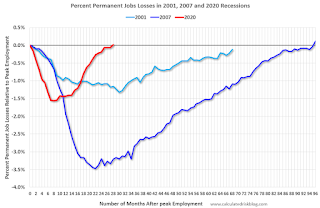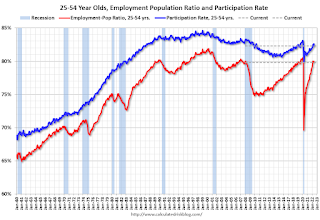by Calculated Risk on 7/08/2022 09:27:00 AM
Friday, July 08, 2022
Comments on June Employment Report
The headline jobs number in the June employment report was above expectations, however employment for the previous two months was revised down by 74,000. The participation rate and the employment-population ratio both decreased slightly, and the unemployment rate was unchanged at 3.6%.
Excluding leisure and hospitality, the economy has 800 thousand more jobs then prior to the pandemic.
Leisure and hospitality gained 67 thousand jobs in June. At the beginning of the pandemic, in March and April of 2020, leisure and hospitality lost 8.20 million jobs, and are now down 1.32 million jobs since February 2020. So, leisure and hospitality has now added back about 84% all of the jobs lost in March and April 2020.
Construction employment increased 13 thousand and is now 46 thousand above the pre-pandemic level.
Manufacturing added 29 thousand jobs and is now 12 thousand above the pre-pandemic level.
Earlier: June Employment Report: 372 thousand Jobs, 3.6% Unemployment Rate
In June, the year-over-year employment change was 6.3 million jobs.
Permanent Job Losers
 Click on graph for larger image.
Click on graph for larger image.
This graph shows permanent job losers as a percent of the pre-recession peak in employment through the report today.
In June, the year-over-year employment change was 6.3 million jobs.
Permanent Job Losers
 Click on graph for larger image.
Click on graph for larger image.This graph shows permanent job losers as a percent of the pre-recession peak in employment through the report today.
This data is only available back to 1994, so there is only data for three recessions.
In June, the number of permanent job losers declined to 1.273 million from 1.386 million in the previous month.
In June, the number of permanent job losers declined to 1.273 million from 1.386 million in the previous month.
These jobs were likely the hardest to recover, so it is a positive that there are fewer permanent job losers now than prior to the recession.
Prime (25 to 54 Years Old) Participation
 Since the overall participation rate has declined due to cyclical (recession) and demographic (aging population, younger people staying in school) reasons, here is the employment-population ratio for the key working age group: 25 to 54 years old.
Since the overall participation rate has declined due to cyclical (recession) and demographic (aging population, younger people staying in school) reasons, here is the employment-population ratio for the key working age group: 25 to 54 years old.The 25 to 54 participation rate decreased in June to 82.3% from 82.6% in May, and the 25 to 54 employment population ratio decreased to 79.8% from 80.0% the previous month.
Both are slightly below the pre-pandemic levels and indicate almost all of the prime age workers have returned to the labor force.
Part Time for Economic Reasons
 From the BLS report:
From the BLS report:
These workers are included in the alternate measure of labor underutilization (U-6) that decreased to 6.7% from 7.1% in the previous month. This is down from the record high in April 22.9% for this measure since 1994. This measure is lower than the 7.0% in February 2020 (pre-pandemic).
Unemployed over 26 Weeks
 This graph shows the number of workers unemployed for 27 weeks or more.
This graph shows the number of workers unemployed for 27 weeks or more.
According to the BLS, there are 1.336 million workers who have been unemployed for more than 26 weeks and still want a job, down from 1.356 million the previous month.
This does not include all the people that left the labor force.
Summary:
The headline monthly jobs number was above expectations; however, the previous two months were revised down by 74,000 combined.
Part Time for Economic Reasons
 From the BLS report:
From the BLS report:"The number of persons employed part time for economic reasons declined by 707,000 to 3.6 million in June and is below its February 2020 level of 4.4 million. These individuals, who would have preferred full-time employment, were working part time because their hours had been reduced or they were unable to find full-time jobs."The number of persons working part time for economic reasons decreased in June to 3.621 million from 4.328 million in May. This is below pre-recession levels.
These workers are included in the alternate measure of labor underutilization (U-6) that decreased to 6.7% from 7.1% in the previous month. This is down from the record high in April 22.9% for this measure since 1994. This measure is lower than the 7.0% in February 2020 (pre-pandemic).
Unemployed over 26 Weeks
 This graph shows the number of workers unemployed for 27 weeks or more.
This graph shows the number of workers unemployed for 27 weeks or more. According to the BLS, there are 1.336 million workers who have been unemployed for more than 26 weeks and still want a job, down from 1.356 million the previous month.
This does not include all the people that left the labor force.
Summary:
The headline monthly jobs number was above expectations; however, the previous two months were revised down by 74,000 combined.
The headline unemployment rate was unchanged at 3.6%.
Look at these highlights:
• U-6 is below pre-recession levels, and the lowest level on record (started in 1994).
• There are now fewer permanent job losers than prior to the recession.
• There are fewer part time workers, for economic reasons, than prior to the recession.
However, there are still 524 thousand fewer jobs than prior to the recession.
Overall, this was another strong report.


